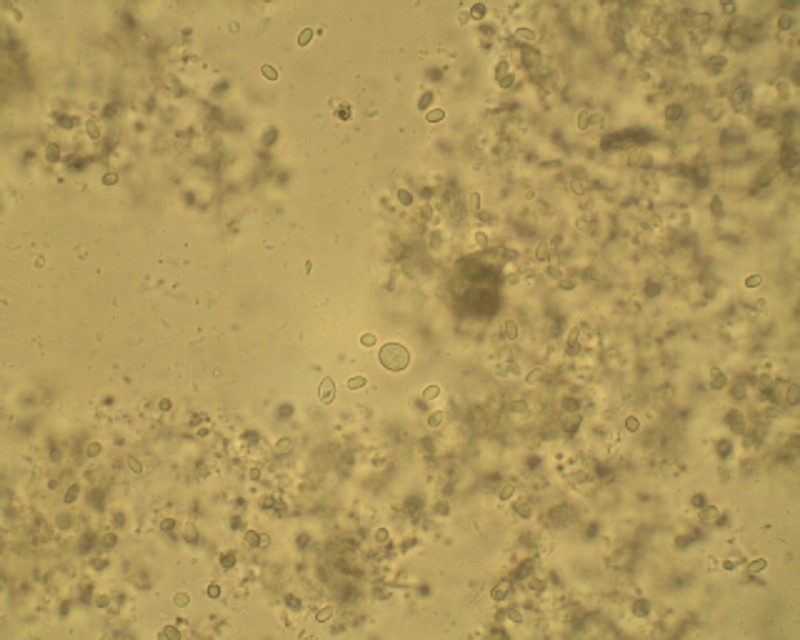Honeybee Diseases - Amoeba
Amoeba (Malpighamoeba mellificae) is a protozoan amoeba-like parasite found in the gut of adult bees that causes encysts in the malpighian tubules - excretory organs, long, threadlike projections originating at the junction of the mid-gut and the hind-gut which act as the bees kidneys. Massive lethal invasions of bees are not frequent and the anatomical protective barriers of the gut limit the destructive action of the parasite. It is not considered a cause colony mortality. The diagnosis of the disease can only be done microscopically, but an apparent inability of healthy-looking colonies to build up may indicate infection.
Download the Amoeba Info Sheet to obtain a printable version of Amoeba information, detection and treatment methods for your records.
Recognition
Image Courtesy The Animal and Plant Health Agency (APHA), Crown Copyright

Nosema apis and Amoeba
The cysts found in the malpighian tubules can only be detected using a compound microscope. The Amoebiasis symptoms are more common in spring and are similar to Nosemosis and often occur together, colony collapse, crawling bees outside the hive unable to fly, diarrhoea - watery faeces of yellowish coloration. There is no known medical treatment against Amoebiasis. Suspect colonies should have samples taken and sent off to SASA in a paper bag for analysis.
Life Cycle - The life of the cysts in the honeycombs is of 6 months in faeces.
Detection
Hive Examination - Examination of hives, components and debris is required especially in spring. Abnormalities such as the signs of dysentery, crawling and dead bees are easily spotted.
Monitoring - Vigilance is important with all honeybee diseases. Check all apiaries and colonies regularly for health and suspect any colonies that are not thriving where there is no already known reason. Colonies that die out should be examined thoroughly and sealed to prevent robbing and spread of any disease present.
Treatment
Presently there is no effective medical treatment for Amoebiasis. Disinfection with acetic acid of the honeycombs destroys the cysts of Amoebiasis and the spores of Nosemosis. The disease has only slight effect on healthy colonies but may have a more serious effect on weakened colonies. Prevention is the best method of controlling this disease by maintaining healthy, strong and vigorous colonies that display good hygienic traits. Good husbandry contributes greatly to overall colony behaviour and health, thereby avoiding the conditions in which disease can flourish. Colonies that suffer excessively from Amoebiasis may need to be re-queened. Some strains of bee are also more prone to infestations than others. Disease prevention is best practice, maintain good apiary housekeeping:
- Always maintain a high level of hygiene in all your beekeeping practices
- Carry out methodical health inspections on a regular basis, checking for brood disease particularly in spring and autumn.
- Never transfer combs between colonies without checking for brood diseases
- Systematically replace old brood combs in your hives melting down the old comb to maintain clean and healthy brood.
- Never bring colonies or equipment into your apiary without establishing their origin, condition, and disease status.
- Sterilise any secondhand equipment or hive components before introducing them into your apiary
- Discourage drifting and robbing in the apiary
- Suspect stray swarm health until you know otherwise
- Report any incidence of disease or suspicious conditions immediately to your local beekeeping association / community.
Vectors
Amoeba can exist in beekeeping equipment, honey, wax, etc. and can spread during normal hive / colony manipulations.
- Beekeepers - Transferring contaminated equipment / material between hives, colonies and apiary sites.
- Crushed Bees - Bees will clean up any crushed bees during normal house keeping activities and can pick up and spread disease quickly through the colony.
- Robbing - Colonies weakened by other ailments will fall prey to robbing, transferring disease to other colonies and apiaries.
- Drifting - As with Robbing will transfer disease to other colonies.
- Swarming - Swarms can carry the spores with them to new sites where the disease can spread.
About the 'My Beekeeping Kit' website.
Contact Iain Dewar for enquiries, suggestions, corrections and contributions for improving the notes. Always welcome!